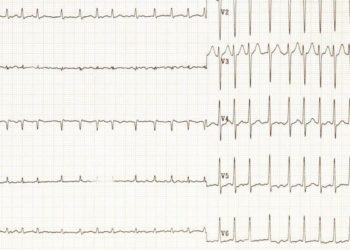Hypercortisolemia in ICU patients is due to reduced cortisol metabolism, not increased production
[tabs tab1=”2MM Rundown” tab2= “2MM Full Report”]
[tab]
Image: PD
1. Only critically ill patients with pronounced inflammation have increased cortisol production. The hypercortisolemia seen in other critically ill patients is a result of impaired cortisol metabolism secondary to reduced expression and activity of cortisol-metabolizing enzymes.
2. Bile acids, known competitive inhibitors and transcriptional suppressors of cortisol-metabolizing enzymes, were increased in patients versus controls and were inversely proportional to enzymatic expression and activity.
Critically ill patients have reduced cortisol breakdown secondary to reduced breakdown of cortisol by cortisol-metabolizing enzymes in the liver and kidney (P≤0.004 for all comparisons). While prevailing wisdom holds that high cortisol levels in critically ill patients is due to stress-induced increases in corticotropin-driven cortisol production, this case control study suggests otherwise. According to this study, critically ill patients demonstrate high cortisol levels in the setting of suppressed corticotropin levels due to a pituitary-independent mechanism. This hypercortisolemia, with concurrent hypocorticotropinism, is a result of impaired cortisol metabolism due to reduced expression and activity of cortisol-metabolizing enzymes. The correlation of low enzyme activity with increased bile acid levels warrants exploration as a possible mechanism. Overall, the study informs our understanding of the stress response in critical illness, with clinical implications for the management of presumed adrenal failure in the ICU.
Click to read the study in NEJM
[/tab]
[tab]
Image: PD
1. Only critically ill patients with pronounced inflammation have increased cortisol production. The hypercortisolemia seen in other critically ill patients is a result of impaired cortisol metabolism secondary to reduced expression and activity of cortisol-metabolizing enzymes.
2. Bile acids, known competitive inhibitors and transcriptional suppressors of cortisol-metabolizing enzymes, were increased in patients versus controls and were inversely proportional to enzymatic expression and activity.
This [case-control] study examined cortisol production and metabolism, and corticotropin levels in 158 ICU patients compared to 64 demographically matched controls. The study measured daily levels of corticotropin and cortisol; plasma cortisol clearance, metabolism and production during infusion of deuterium-labeled steroid hormones as tracers; plasma clearance of hydrocortisone; levels of urinary cortisol metabolites; and levels of messenger RNA and protein in liver and adipose tissue, to assess major cortisol-metabolizing enzymes.
Cortisol was 83% higher and corticotropin was lower in patients vs. controls. However, cortisol production was only higher in patients with concurrent increases in proinflammatory cytokines TNFa and IL-6. Clearance of cortisol was reduced >50%, paralleled by significant reduction in mRNA, protein and enzymatic activity of cortisol-metabolizing enzymes. In addition, enzymatic expression and activity was negatively correlated with bile acid levels.
In sum: Critically ill patients have reduced cortisol breakdown secondary to reduced breakdown of cortisol by cortisol-metabolizing enzymes in the liver and kidney (P≤0.004 for all comparisons). While prevailing wisdom holds that high cortisol levels in critically ill patients is due to stress-induced increases in corticotropin-driven cortisol production, this case control study suggests otherwise. According to this study, critically ill patients demonstrate high cortisol levels in the setting of suppressed corticotropin levels due to a pituitary-independent mechanism. This hypercortisolemia, with concurrent hypocorticotropinism, is a result of impaired cortisol metabolism due to reduced expression and activity of cortisol-metabolizing enzymes. The correlation of low enzyme activity with increased bile acid levels warrants exploration as a possible mechanism. Overall, the study informs our understanding of the stress response in critical illness, with clinical implications for the management of presumed adrenal failure in the ICU.
Click to read the study in NEJM
By Jessica Mitchell and Mitalee Patil
More from this author: Ischemic heart disease increases linearly with radiotherapy for breast cancer, Ondansetron (Zofran) is safe for treatment of nausea in pregnancy, Dabigatran is noninferior to warfarin for VTE
© 2013 2minutemedicine.com. All rights reserved. No works may be reproduced without written consent from 2minutemedicine.com. Disclaimer: We present factual information directly from peer reviewed medical journals. No post should be construed as medical advice and is not intended as such by the authors or by 2minutemedicine.com. PLEASE SEE A HEALTHCARE PROVIDER IN YOUR AREA IF YOU SEEK MEDICAL ADVICE OF ANY SORT. Content is produced in accordance with fair use copyrights solely and strictly for the purpose of teaching, news and criticism. No benefit, monetary or otherwise, is realized by any participants or the owner of this domain.
[/tab]
[/tabs]







![PFO closure equivalent to medical management in prevention of recurrent stroke [PC and RESPECT trials]](https://www.2minutemedicine.com/wp-content/uploads/2013/03/Echokardiogram_von_Atriumseptumdefekt_Ostium_secundum1-75x75.jpg)